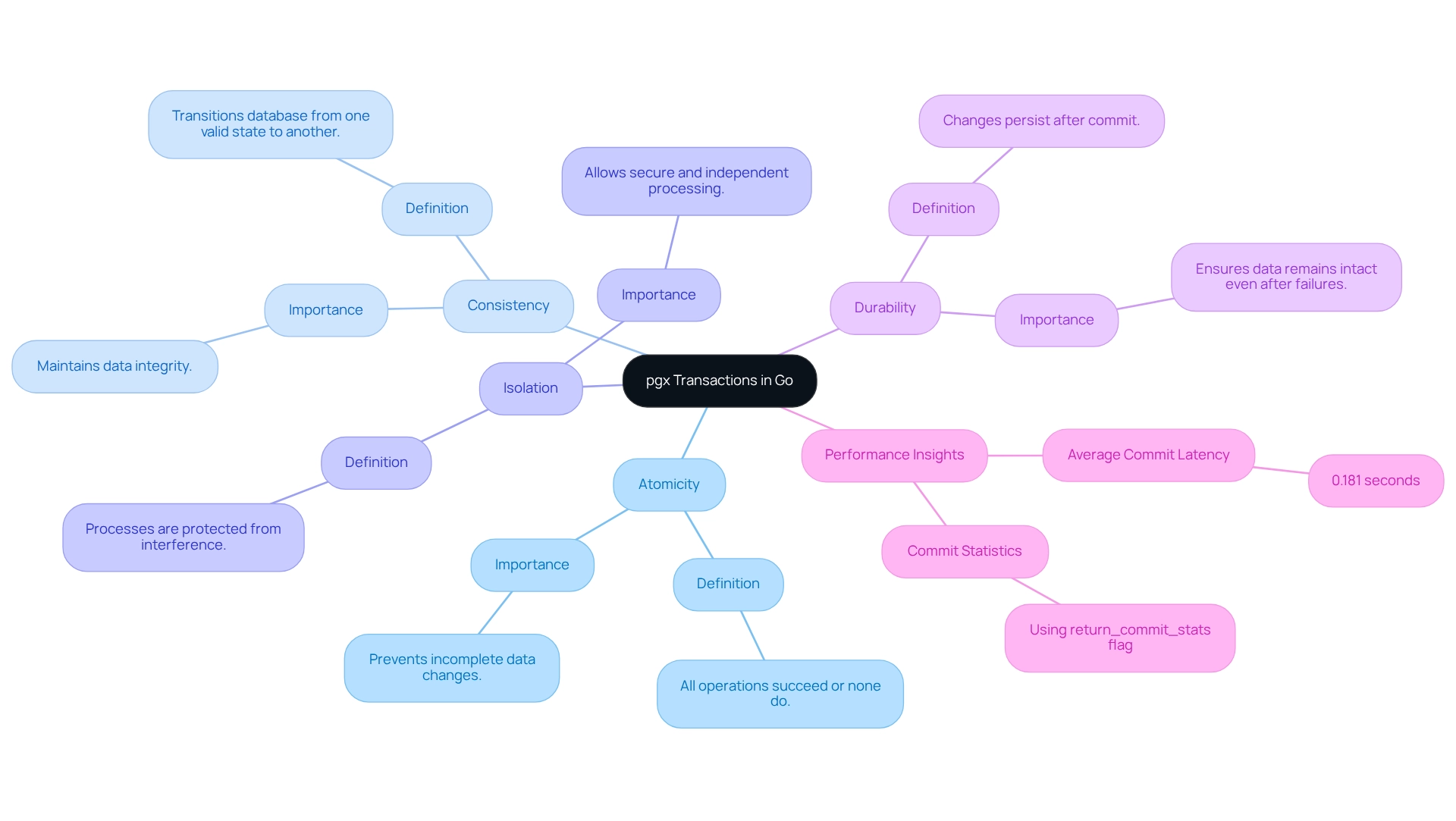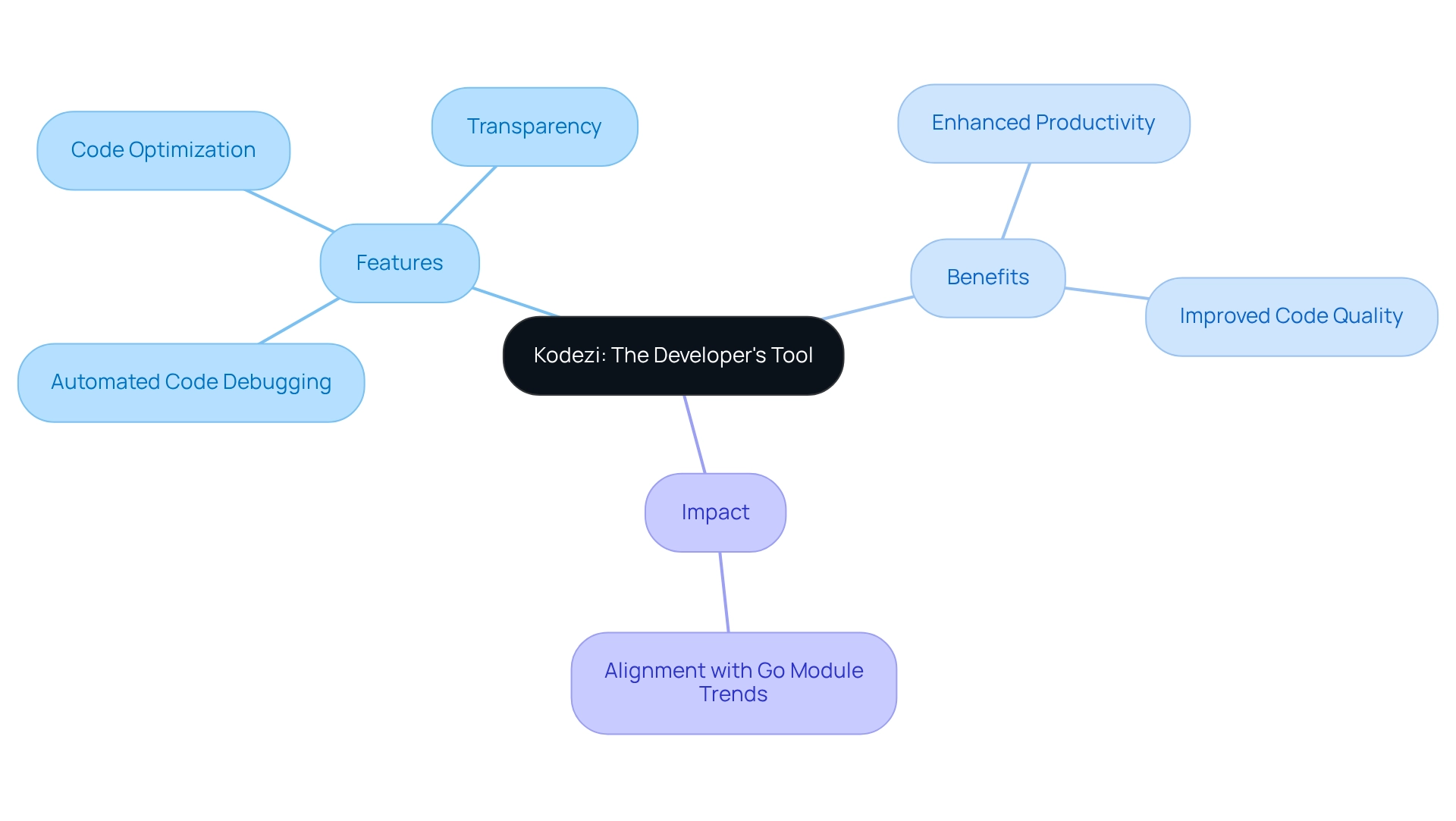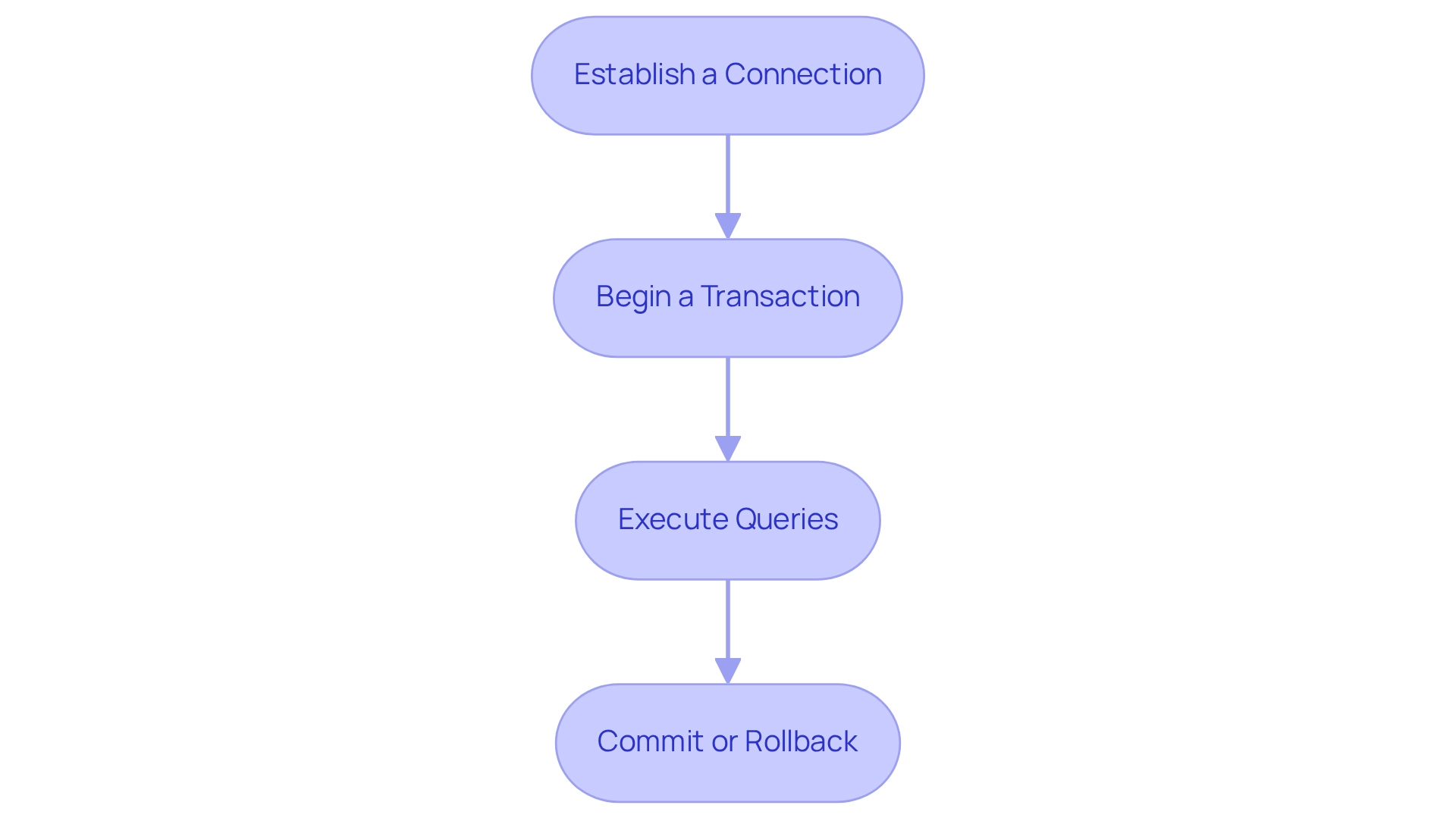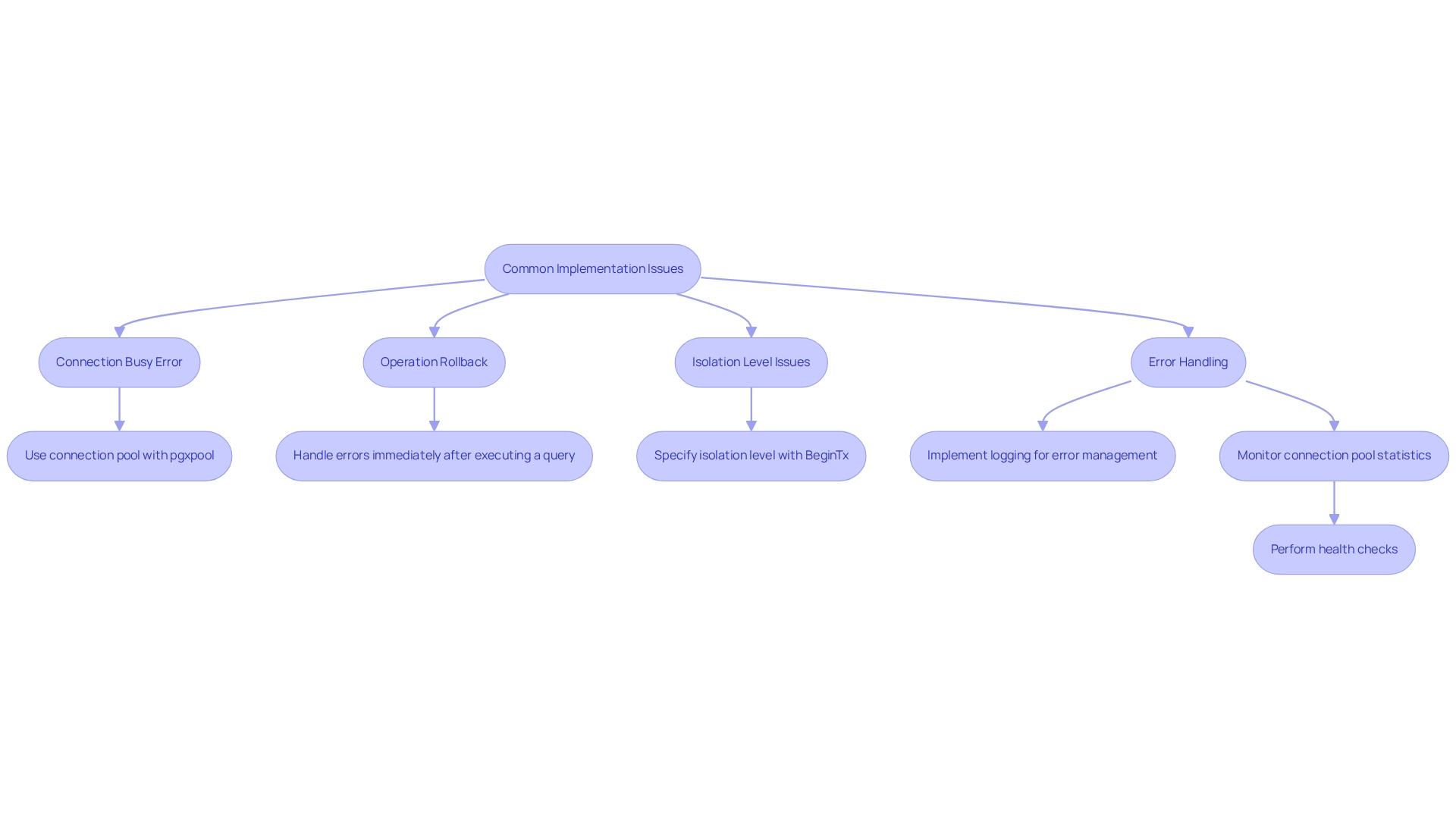Overview
Mastering the implementation of pgx transactions in Go applications is essential for ensuring data integrity. Developers often encounter challenges in managing database operations effectively. Understanding key transaction principles—atomicity, consistency, isolation, and durability—can significantly alleviate these challenges. By grasping these concepts, developers can enhance their coding practices and improve overall application performance.
Furthermore, practical steps and troubleshooting tips are vital for effectively managing database operations. These guidelines reinforce the necessity of robust transaction handling in Go programming. When developers are equipped with the right tools and knowledge, they can navigate the complexities of database transactions with greater confidence.
In addition, focusing on these principles not only aids in maintaining data integrity but also boosts productivity. By implementing best practices for transaction management, developers can ensure their applications run smoothly and efficiently. This approach ultimately leads to higher quality code and more reliable applications.
Introduction
In the realm of software development, are you facing challenges with data integrity and reliability? Mastering transaction management is a cornerstone for addressing these issues, particularly when working with databases in Go. With the pgx library at hand, developers can harness the power of transactions to execute multiple operations as a cohesive unit. This safeguards against partial updates that could compromise data quality.
This article delves into the essential concepts of pgx transactions. It provides a comprehensive guide that spans from establishing a robust development environment to troubleshooting common pitfalls. By understanding the principles of atomicity, consistency, isolation, and durability, developers can enhance application performance and stability. Ultimately, this leads to more efficient and secure data handling in their Go applications.
Are you ready to elevate your coding practices? Let’s explore how mastering these concepts can significantly improve your productivity and code quality.
Understand pgx Transactions in Go
In Go, processes empower developers to execute a series of operations as a single unit of work, ensuring that either all operations succeed or none do. This capability is crucial for maintaining data integrity, particularly when utilizing the pgx transaction, which offers a user-friendly API for managing operations. Developers can start a process with Begin, carry out their queries, and then either commit or rollback based on the success of those operations. Mastering the implementation of processes is essential for any Go programmer working with databases, as it prevents partial updates that could lead to data corruption.
Key Concepts of Processes:
- Atomicity: Guarantees that all operations within a process are completed successfully or none at all, safeguarding against incomplete data changes.
- Consistency: Ensures that a process transitions the database from one valid state to another, maintaining the integrity of the data.
- Isolation: Protects processes from interference, allowing them to be processed securely and independently, even when executed concurrently.
- Durability: Once a process is committed, it remains so, ensuring that the changes persist even in the event of a system failure.
Understanding these principles is vital for effective management in Go applications. For instance, a recent study revealed that the average commit latency was 0.181 seconds. This statistic underscores the importance of enhancing performance to improve application responsiveness. Furthermore, incorporating the return_commit_stats flag in Spanner's CommitRequest can provide programmers with detailed commit statistics. These insights can be utilized in pgx transaction operations to identify performance bottlenecks and optimize handling. By mastering these concepts, developers can ensure their applications manage data reliably and securely, reinforcing the essential role of processes in maintaining data integrity.

Prepare Your Development Environment
In the world of software development, coding challenges can often impede progress. How can developers overcome these hurdles effectively? Enter Kodezi, a powerful tool designed to streamline your coding experience. With features such as automated code debugging and optimization, Kodezi addresses common pain points, allowing you to focus on what truly matters—building robust applications.
By utilizing Kodezi, you can significantly enhance your productivity and code quality. Imagine being able to identify and fix issues in your code automatically, freeing up valuable time for more critical tasks. This not only improves the quality of your work but also aligns with current trends in Go module usage, making it a smart choice for modern developers.
Are you ready to elevate your coding practices? Kodezi, often referred to as the 'Swiss-Army Knife for programmers,' has been dedicated to transparency and quality since its establishment in 2019. Backed by a global team and investors, Kodezi empowers developers to maintain high standards in their code. The case study

Implement pgx Transactions in Your Code
Implementing a pgx transaction in your Go application is essential for maintaining data integrity. Have you ever faced challenges in ensuring your database operations are reliable? Follow these steps to effectively manage transactions and enhance your application's stability.
-
Establish a Connection: Connect to your PostgreSQL database using the following code snippet:
package main import ( "context" "fmt" "github.com/jackc/pgx/v5" ) func main() { conn, err := pgx.Connect(context.Background(), "postgres://user:password@localhost:5432/mydb") if err != nil { fmt.Println("Unable to connect to database:", err) return } defer conn.Close(context.Background()) } -
Begin a Transaction: Start a transaction using the
Beginmethod:tx, err := conn.Begin(context.Background()) if err != nil { fmt.Println("Failed to begin transaction:", err) return } -
Execute Queries: Perform your database operations within the transaction:
_, err = tx.Exec(context.Background(), "INSERT INTO users(name) VALUES($1)", "John Doe") if err != nil { tx.Rollback(context.Background()) fmt.Println("Failed to execute query:", err) return } -
Commit or Rollback: Finally, commit the transaction if all operations succeed, or rollback if any operation fails:
if err := tx.Commit(context.Background()); err != nil { fmt.Println("Failed to commit transaction:", err) }
Implementing transactions correctly is crucial for maintaining data integrity, as transactions must be completed entirely or not at all. This principle is underscored by a case study on error management in pgx transactions, which emphasizes the significance of robust systems to recover from unforeseen issues. By ensuring proper rollback procedures, you can maintain stability and data integrity in your applications. By following these steps, you can effectively oversee activities in your Go application using a pgx transaction, ensuring reliable execution of your database operations. Remember, executing a transaction finalizes the changes made during the process, reinforcing its critical role in the overall procedure.

Troubleshoot Common Implementation Issues
When executing a pgx transaction, developers often encounter various challenges. Are you facing issues with your database connections? Here are some troubleshooting tips that can help you navigate these common obstacles:
-
Connection Busy Error: If you encounter a 'connection busy' error, it signifies that the same link is being utilized for several operations at the same time. To manage connections more effectively, utilize a connection pool with
pgxpool:pool, err := pgxpool.Connect(context.Background(), "postgres://user:password@localhost:5432/mydb") -
Operation Rollback: Unforeseen operation rollbacks frequently arise from mistakes in SQL queries. Always handle errors immediately after executing a query to ensure that you can rollback if necessary.
-
Isolation Level Issues: For data consistency problems, specify the isolation level when initiating a process. Use
BeginTxto set the desired isolation level:tx, err := conn.BeginTx(context.Background(), pgx.TxOptions{IsoLevel: pgx.Serializable}) -
Error Handling: Proper error management at every stage of your process is crucial. Implement logging to capture error messages, aiding in the diagnosis of issues.
Furthermore, monitoring connection pool statistics is essential for maintaining optimal performance in Go applications. Regularly tracking counts of successful acquires and connections destroyed due to limits allows developers to identify potential issues and manage connection limits effectively, ensuring that applications remain responsive under varying loads. Notably, since the new deployment, there have been no pages overwhelming the system, indicating a stable environment for your implementations.
The case study titled "Monitoring Connection Pool Statistics" emphasizes the need for monitoring these statistics to maintain optimal performance. By being aware of these common issues and their solutions, you can streamline your development process and enhance the reliability of your implementations of the pgx transaction. As a best practice, remember to perform health checks to ensure available and healthy connections.

Conclusion
Mastering transaction management in Go using the pgx library is essential for ensuring data integrity and reliability in applications. Developers often face challenges related to partial updates and data quality. By understanding the core principles of transactions—atomicity, consistency, isolation, and durability—they can implement robust solutions that safeguard against these issues.
Establishing a well-prepared environment and following the outlined steps for implementing transactions not only enhances developer productivity but also leads to more secure and efficient code. Furthermore, the insights shared regarding performance optimization and error handling serve as valuable tools for developers, enabling them to refine their approach to transaction management.
In conclusion, prioritizing transaction management in Go applications is crucial for delivering reliable software solutions. By embracing the concepts and practices discussed, developers can elevate their coding practices, ensuring that their applications are resilient, performant, and capable of handling data with the utmost integrity. The journey to mastering pgx transactions is not just about learning a new skill; it's about committing to excellence in software development.
Frequently Asked Questions
What is the purpose of processes in Go when working with databases?
Processes in Go allow developers to execute a series of operations as a single unit of work, ensuring that either all operations succeed or none do, which is crucial for maintaining data integrity.
How does the pgx transaction facilitate process management in Go?
The pgx transaction provides a user-friendly API that enables developers to start a process with Begin, perform queries, and then either commit or rollback based on the success of those operations.
What are the key concepts of processes in Go?
The key concepts include: - Atomicity: Ensures all operations are completed successfully or none at all. - Consistency: Maintains the integrity of the data by transitioning the database from one valid state to another. - Isolation: Protects processes from interference, allowing them to operate securely and independently. - Durability: Guarantees that once a process is committed, the changes persist even in case of a system failure.
Why is mastering the implementation of processes important for Go programmers?
Mastering processes is essential for Go programmers working with databases to prevent partial updates that could lead to data corruption.
What is the significance of commit latency in Go applications?
A study revealed that the average commit latency was 0.181 seconds, highlighting the importance of enhancing performance to improve application responsiveness.
How can developers gain insights into commit performance in Spanner's CommitRequest?
By incorporating the return_commit_stats flag, developers can obtain detailed commit statistics that can help identify performance bottlenecks and optimize handling in pgx transaction operations.




